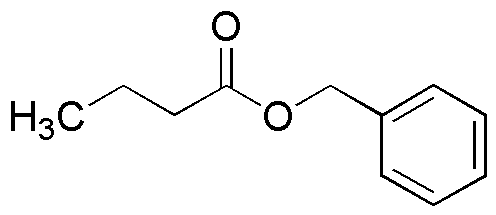Benzyl butyrate is widely utilized in research focused on various applications across different industries. Here are five practical uses:
- Flavoring Agent: Commonly used in the food industry, it imparts a fruity flavor to products such as candies, baked goods, and beverages, enhancing their appeal.
- Fragrance Component: In the cosmetics and personal care sector, it serves as a fragrance ingredient in perfumes, lotions, and soaps, providing a pleasant scent profile.
- Solvent in Chemical Reactions: It acts as a solvent in organic synthesis, facilitating reactions and extractions, which is essential for researchers in laboratories.
- Plasticizer: Employed in the production of plastics, it improves flexibility and durability, making it valuable in manufacturing processes for various plastic products.
- Aromatic Compound in Research: Used in studies related to flavor and fragrance chemistry, it helps researchers understand the interactions and properties of aromatic compounds.
General Information
Properties
Safety and Regulations
Applications
Benzyl butyrate is widely utilized in research focused on various applications across different industries. Here are five practical uses:
- Flavoring Agent: Commonly used in the food industry, it imparts a fruity flavor to products such as candies, baked goods, and beverages, enhancing their appeal.
- Fragrance Component: In the cosmetics and personal care sector, it serves as a fragrance ingredient in perfumes, lotions, and soaps, providing a pleasant scent profile.
- Solvent in Chemical Reactions: It acts as a solvent in organic synthesis, facilitating reactions and extractions, which is essential for researchers in laboratories.
- Plasticizer: Employed in the production of plastics, it improves flexibility and durability, making it valuable in manufacturing processes for various plastic products.
- Aromatic Compound in Research: Used in studies related to flavor and fragrance chemistry, it helps researchers understand the interactions and properties of aromatic compounds.
Documents
Safety Data Sheets (SDS)
The SDS provides comprehensive safety information on handling, storage, and disposal of the product.
Product Specification (PS)
The PS provides a comprehensive breakdown of the product’s properties, including chemical composition, physical state, purity, and storage requirements. It also details acceptable quality ranges and the product's intended applications.
Certificates of Analysis (COA)
Search for Certificates of Analysis (COA) by entering the products Lot Number. Lot and Batch Numbers can be found on a product’s label following the words ‘Lot’ or ‘Batch’.
Numéro de catalogue
Numéro de lot/série
Certificates Of Origin (COO)
This COO confirms the country where the product was manufactured, and also details the materials and components used in it and whether it is derived from natural, synthetic, or other specific sources. This certificate may be required for customs, trade, and regulatory compliance.
Numéro de catalogue
Numéro de lot/série
Safety Data Sheets (SDS)
The SDS provides comprehensive safety information on handling, storage, and disposal of the product.
DownloadProduct Specification (PS)
The PS provides a comprehensive breakdown of the product’s properties, including chemical composition, physical state, purity, and storage requirements. It also details acceptable quality ranges and the product's intended applications.
DownloadCertificates of Analysis (COA)
Search for Certificates of Analysis (COA) by entering the products Lot Number. Lot and Batch Numbers can be found on a product’s label following the words ‘Lot’ or ‘Batch’.
Numéro de catalogue
Numéro de lot/série
Certificates Of Origin (COO)
This COO confirms the country where the product was manufactured, and also details the materials and components used in it and whether it is derived from natural, synthetic, or other specific sources. This certificate may be required for customs, trade, and regulatory compliance.

